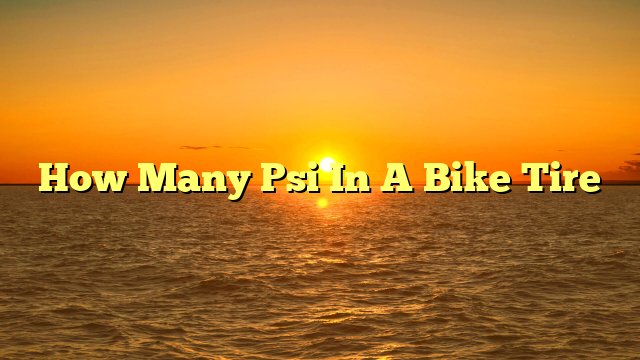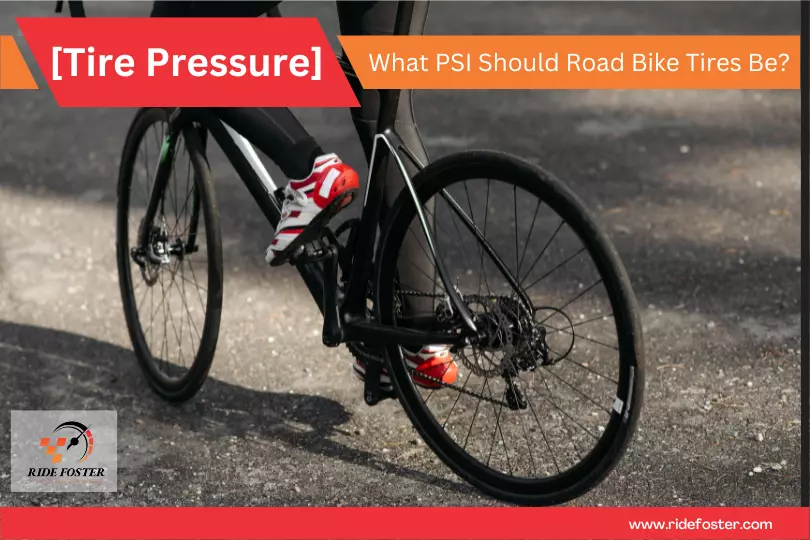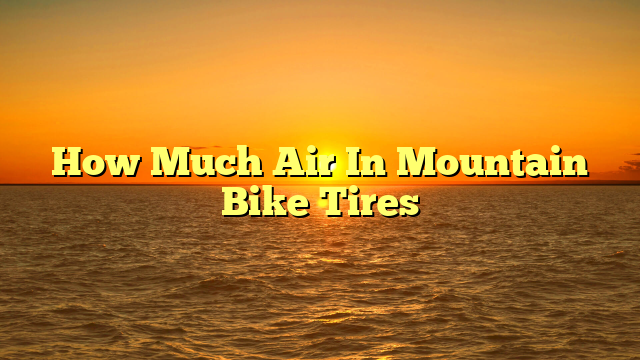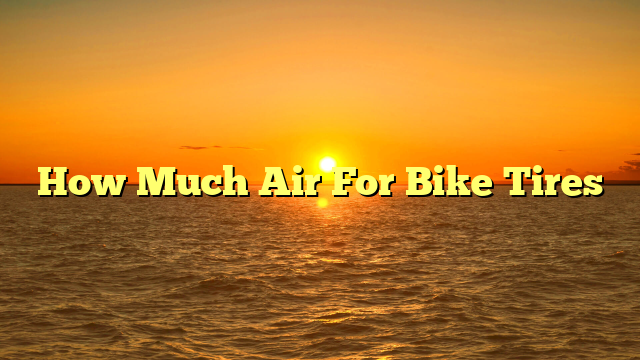Tire pressure is a crucial aspect of bike maintenance that can significantly impact the performance and safety of a ride.
The appropriate tire pressure helps to ensure optimal grip, stability, and control of the bike, making it essential for riders to understand how to determine the correct psi for their bike tires.
In this article, we will explore the factors that affect the recommended psi for bike tires, how to read a tire’s sidewall for information, and how to use a tire pressure gauge to measure psi accurately.
We will also discuss how to calculate the recommended psi for different types of bike tires and how to adjust tire pressure for various riding conditions.
Finally, we will provide tips for maintaining proper tire pressure and why it is crucial for your safety and the longevity of your bike.
Table of Contents
- 1 Key Takeaways
- 2 Understanding Tire Pressure and Its Importance
- 3 Factors Affecting Recommended PSI for Bike Tires
- 4 Reading Your Bike Tire’s Sidewall for Information
- 5 Using a Tire Pressure Gauge to Measure PSI
- 6 Calculating the Recommended PSI for Your Bike Tires
- 7 Adjusting Tire Pressure for Different Riding Conditions
- 8 Tips for Maintaining Proper Tire Pressure
- 9 Frequently Asked Questions
- 10 Conclusion
Key Takeaways
- Optimal tire pressure is crucial for bike maintenance, performance, and safety.
- Recommended PSI for bike tires depends on factors such as rider weight, tire type, and surface conditions.
- Overinflated and underinflated tires can have serious consequences on performance and safety.
- Measuring tire pressure with a gauge is crucial for maintaining optimal performance and safety, and different types of gauges are available.
Understanding Tire Pressure and Its Importance
The appropriate tire pressure in a bike tire is a crucial factor in determining the overall performance and safety of the bicycle.
Proper tire pressure is essential for ensuring optimal traction, stability, and control when cycling.
Additionally, maintaining the appropriate tire pressure can extend the lifespan of the tire and prevent unnecessary wear and tear.
The importance of tire maintenance cannot be overstated, as incorrect tire pressure can have serious consequences.
Overinflated tires can lead to reduced traction and stability, making it difficult to control the bike and increasing the risk of accidents.
Underinflated tires, on the other hand, can cause excessive wear and tear, reducing the lifespan of the tire and potentially leading to a blowout while cycling.
By regularly checking and maintaining the appropriate tire pressure, cyclists can ensure maximum performance and safety while on the road.
Factors Affecting Recommended PSI for Bike Tires
Factors such as rider weight, tire type, and surface conditions are important considerations in determining the appropriate level of air pressure for optimal performance and safety of a bicycle.
Tire type plays a crucial role in determining the recommended PSI for bike tires.
For instance, a road bike tire requires a higher PSI compared to a mountain bike tire.
This is because road bike tires are thinner and require more pressure to support the weight of the rider.
On the other hand, mountain bike tires are thicker and require less pressure to support the weight of the rider.
Rider weight also plays a significant role in determining the recommended PSI for bike tires.
The more a rider weighs, the higher the recommended PSI.
This is because the weight of the rider compresses the tire, making it flatter and reducing the tire’s contact patch with the ground.
Therefore, a higher PSI is necessary to support the weight of the rider and maintain the tire’s shape.
Conversely, a lighter rider requires a lower PSI as the tire is not compressed as much and does not require as much support.
It is important to note that following the recommended PSI for bike tires is crucial in ensuring optimal performance and safety.
Reading Your Bike Tire’s Sidewall for Information
Examining the markings on the sidewall of a bicycle tire can provide valuable information for riders to ensure they are using the appropriate tire for their needs and riding conditions.
The markings on the sidewall include information about the tire’s size, type, and recommended pressure.
Decoding sidewall markings can help riders choose the right tire type and ensure they are inflating their tires to the correct pressure.
One way to decode sidewall markings is to look for the tire size, which is typically represented by a series of numbers separated by an “x.”For example, a tire with the markings “700x25c” indicates that the tire has a diameter of 700 millimeters and a width of 25 millimeters.
The letter “c” at the end indicates that the tire has a clincher bead, which is the type of tire that is most commonly used on road bikes.
In addition to the tire size, the sidewall markings may also include information about the tire’s recommended pressure range.
Choosing the right tire type and inflating it to the recommended pressure can help ensure a smooth and safe ride.
| Tire Type | Description | Best For |
|---|---|---|
| Road | Narrow, smooth tread | Smooth pavement, high-speed riding |
| Mountain | Wide, knobby tread | Rough terrain, off-road riding |
| Hybrid | Smooth tread with slight tread pattern | Commuting, recreational riding |
| Cyclocross | Tread designed for mixed terrain | Racing, off-road riding |
The table above provides a brief overview of some common tire types and their best uses.
It is important for riders to choose the right tire type for their needs and to ensure that they are inflating their tires to the recommended pressure.
By decoding sidewall markings and selecting the appropriate tire, riders can enjoy a comfortable and safe ride.
Using a Tire Pressure Gauge to Measure PSI
Measuring tire pressure with a gauge is a crucial step in maintaining optimal performance and safety while riding a bicycle.
The accuracy of the measurement is essential as it impacts the bike’s handling, traction, and stability.
Underinflated tires can lead to increased rolling resistance, increased wear on the tire, and a higher risk of punctures, while overinflated tires can lead to a harsher ride, reduced traction, and an increased risk of blowouts.
To ensure measuring accuracy, it is crucial to use a reliable and accurate tire pressure gauge.
Common mistakes that can affect the accuracy of the measurement include not checking tire pressure when the tire is cold, not using the appropriate gauge for the type of valve, or not checking the gauge’s calibration regularly.
Different types of tire pressure gauges are available, including analog gauges, digital gauges, and dial gauges.
Analog gauges are typically the most affordable but can be less accurate and may require more effort to use.
Digital gauges are more expensive but offer high accuracy and are easier to read.
Dial gauges are typically used by professional mechanics and offer high accuracy and precision.
Measuring tire pressure with a gauge is an essential step in ensuring optimal bike performance and safety.
To maintain accurate measurements, it is crucial to use a reliable and accurate gauge and avoid common mistakes that can affect the accuracy of the measurement.
Different types of tire pressure gauges are available, each with its advantages and disadvantages, and choosing the right gauge depends on personal preference and needs.
Calculating the Recommended PSI for Your Bike Tires
Determining the appropriate air pressure for your bicycle’s tires is crucial for maintaining optimal performance and safety.
Optimal inflation is essential for ensuring a smooth and comfortable ride that will allow you to fully enjoy your cycling experience.
Moreover, it can help to prevent tire wear and minimize the risk of punctures or blowouts.
To calculate the recommended PSI for your bike tires, you should consider several factors, including the type of bike you have, your weight, and the road conditions you will encounter.
A general rule of thumb is that road bike tires should be inflated to around 80-130 PSI, while mountain bike tires will require less air pressure, typically between 30-50 PSI.
However, these figures are not set in stone, and you may need to adjust the pressure based on your own needs and preferences.
Experimenting with different levels of inflation can help you find the perfect balance between performance, comfort, and safety.
Adjusting Tire Pressure for Different Riding Conditions
Adapting tire pressure to varying riding conditions can greatly improve both performance and safety while cycling.
Mountain biking, for instance, requires a lower tire pressure than road cycling.
This is because the former requires greater traction on uneven and rocky terrain, and lower pressure allows the tire to conform to the surface for better grip.
A recommended tire pressure for mountain biking ranges from 22-35 psi, depending on the rider’s weight, tire size, and terrain.
Riders can experiment with different pressure levels to find the one that works best for them.
On the other hand, road cycling requires higher tire pressure to reduce rolling resistance and increase speed.
Higher pressure also reduces the risk of pinch flats and punctures.
A recommended tire pressure for road cycling ranges from 80-130 psi, depending on the rider’s weight, tire size, and road conditions.
Riders should always check their tire pressure before a ride to ensure optimal performance and safety.
Adapting tire pressure to varying riding conditions is a crucial aspect of cycling that riders should not overlook.
Tips for Maintaining Proper Tire Pressure
Maintaining proper tire pressure is crucial to ensuring optimal performance and safety while cycling, and neglecting this aspect can lead to disastrous consequences on the road or trail.
Here are some tips for maintaining proper tire pressure:
- Importance of consistency: It is important to maintain consistent tire pressure levels to prevent damage to the tires and ensure optimal performance.
Consistency is key to reducing the risk of flats and other issues while riding.
- Checking pressure before and after rides: The tire pressure should be checked before and after every ride to ensure that it is at the correct level.
This will help to prevent issues such as flats and other problems that can arise from low or high tire pressure levels.
- Use a quality tire pressure gauge: It is important to use a high-quality tire pressure gauge to ensure accurate readings.
Using a low-quality gauge can result in inaccurate readings, which can lead to over or under-inflation of the tire.
- Know the recommended pressure for your bike: Different bikes have different recommended tire pressure levels.
It is important to know the recommended pressure for your bike to ensure optimal performance and safety.
- Adjust tire pressure for different riding conditions: Different riding conditions require different tire pressure levels.
Adjusting the tire pressure based on the riding conditions can help to improve performance and safety while riding.
By following these tips, cyclists can maintain proper tire pressure levels, which can help to prevent issues and ensure optimal performance and safety while riding.
Frequently Asked Questions
What happens if I overinflate my bike tires?
Overinflated bike tires pose risks such as reduced traction, increased susceptibility to punctures, and decreased rider control.
Properly checking tire pressure with a gauge can prevent overinflation and ensure optimal performance.
Can I use the same tire pressure for all types of bikes?
Tire pressure should be adjusted based on the type of bike and terrain.
Road bikes typically require higher pressure for less rolling resistance, while mountain bikes need lower pressure for better traction and shock absorption.
Incorrect tire pressure can negatively impact bike handling and performance.
How often should I check my bike tire pressure?
Regularly checking tire pressure is essential for optimal bike performance and safety.
Benefits of maintaining proper tire pressure include improved handling, reduced risk of flats, and increased efficiency.
Tips for checking the tire pressure on the go include using a portable pump or gauge and checking pressure before every ride.
Is it safe to ride with low tire pressure?
Riding a bike with low tire pressure can negatively affect performance and compromise safety.
It can cause the tire to wear unevenly, increase rolling resistance, and reduce stability.
Maintaining proper tire pressure is crucial for optimal performance and safety.
What is the maximum and minimum PSI for bike tires?
The minimum and maximum psi for road bike tires vary depending on the tire size and rider weight, but typically range from 80-120 psi.
Recommended psi for mountain bike tires is lower, ranging from 30-50 psi for better traction and shock absorption on rough terrain.
Conclusion
In conclusion, understanding the recommended PSI for your bike tires is crucial for maintaining optimal performance and safety while riding.
Factors such as tire width, rider weight, and riding conditions can all impact the recommended PSI level.
It is important to read the sidewall of your tire to determine the proper PSI range and use a tire pressure gauge to accurately measure the pressure level.
Calculating the recommended PSI for your bike tires can be done by using a simple formula that takes into account the rider’s weight and the tire width.
Additionally, adjusting tire pressure for different riding conditions such as off-road or wet pavement can further enhance safety and performance.
By maintaining proper tire pressure, riders can reduce the risk of flats, improve handling, and increase overall efficiency on the road or trail.







